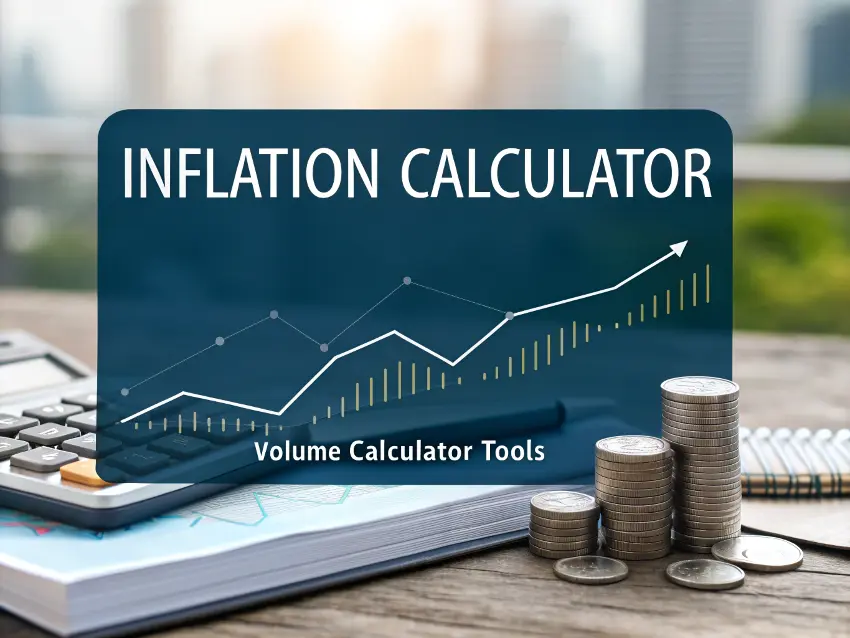Inflation Calculator
Calculate the effects of inflation on your money over time

Understanding Inflation
What is Inflation?
Inflation is the rate at which the general level of prices for goods and services rises, causing purchasing power to fall over time. It's typically measured as an annual percentage.
In simple terms, as inflation rises, every dollar you own buys a smaller percentage of a good or service. If the inflation rate is 2%, then a $1 item will cost $1.02 a year later.
Inflation Formula:
FV = PV × (1 + i)^n
Where:
- FV = Future value (inflation-adjusted amount)
- PV = Present value (original amount)
- i = Inflation rate (decimal)
- n = Number of years
Historical Inflation Data (US):
Source: U.S. Bureau of Labor Statistics, Consumer Price Index (CPI)
Inflation Impact
- Erodes Purchasing Power: Your money buys less over time
- Affects Fixed Income: Especially impacts retirees on fixed incomes
- Reduces Debt Value: Can benefit borrowers with fixed-rate loans
- Impacts Investments: Cash loses value, while some assets may keep pace
- Compounds Over Time: Even low inflation rates have significant long-term effects
Calculate Inflation Impact
Amount and Time Period
$
Inflation Rate
%
Historical average from 1913-2023: ~3.1%
Inflation Impact Results
Original Amount (2000):
$1,000.00
Adjusted Amount (2025):
$0.00
Price Change:
+0.0%
Over 25 years
Purchasing Power Loss:
0.0%
$1,000.00 in 2000 = $1,000.00 in 2025 dollars
What this means: $1,000.00 in 2000 has the same buying power as $0.00 in 2025. This represents a 0.0% increase in the price level, meaning your money has lost 0.0% of its purchasing power.
Value Change Over Time
Inflation in Everyday Life
Price Changes Over Time
| Item | 1980 | 2000 | 2023 | % Change (1980-2023) |
|---|---|---|---|---|
| Gallon of Milk | $2.16 | $2.78 | $4.30 | +99% |
| Gallon of Gas | $1.19 | $1.51 | $3.50 | +194% |
| Movie Ticket | $2.69 | $5.39 | $11.75 | +337% |
| New Car (average) | $7,210.00 | $21,900.00 | $48,000.00 | +566% |
| Single-Family Home (median) | $47,200.00 | $163,000.00 | $410,500.00 | +770% |
| College Tuition (annual, public) | $2,550.00 | $8,400.00 | $25,700.00 | +908% |
Source: U.S. Bureau of Labor Statistics and historical price data. Figures are approximate.
Protecting Against Inflation
Investments
Stocks, real estate, and certain commodities have historically provided returns that outpace inflation over the long term, helping preserve purchasing power.
Treasury Inflation-Protected Securities (TIPS)
These government bonds are indexed to inflation, providing protection from rising prices by adjusting their principal value with changes in the Consumer Price Index.
I Bonds
Series I savings bonds have an interest rate that combines a fixed rate and an inflation rate, providing protection against inflation for individual investors.
Income Growth
Focus on careers and investments that offer income growth potential to help your earnings keep pace with or exceed inflation rates.
Avoid Long-Term Cash Holdings
Large cash positions are vulnerable to inflation erosion. Keep only what you need for emergencies and short-term goals in cash equivalents.
Factors That Influence Inflation
Demand-Pull Inflation
Occurs when aggregate demand exceeds available supply, pulling prices higher. This can happen during periods of strong economic growth, excessive government spending, or expansionary monetary policy.
Cost-Push Inflation
Results from increases in production costs, such as raw materials, wages, or energy prices, which businesses pass on to consumers through higher prices. Supply chain disruptions can also contribute.
Monetary Inflation
Caused by an expansion of the money supply that outpaces economic growth. When there is more money chasing the same amount of goods and services, prices tend to rise.
Inflation FAQs
What is the difference between inflation and hyperinflation?
Inflation refers to a general increase in prices and fall in purchasing power, typically at rates below 10% annually. Hyperinflation is an extremely rapid form of inflation, typically measuring more than 50% per month, which can quickly destroy the value of a currency.
How is inflation measured?
In the United States, inflation is primarily measured by the Consumer Price Index (CPI), which tracks the weighted average price of a basket of goods and services. Other measures include the Personal Consumption Expenditures (PCE) Price Index and the Producer Price Index (PPI).
Is all inflation bad?
Mild inflation (around 2%) is generally considered beneficial for economic growth. It encourages spending and investment rather than holding cash, helps wages adjust to economic changes, and makes it easier for borrowers to repay debts with "cheaper" future dollars. However, high or unpredictable inflation disrupts economic planning and can harm growth.
Why don't all prices rise at the same rate during inflation?
Different sectors of the economy face different supply and demand conditions, labor costs, productivity improvements, and competitive pressures. Some products may even decrease in price during inflation due to technological advances or increased efficiency, while others might rise faster than the average inflation rate.